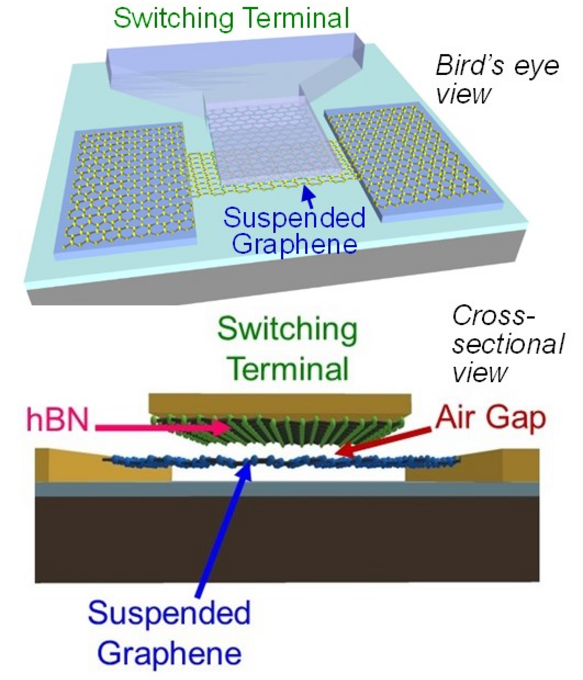The thirst for a perfect switching device for ultra-low power applications results in an investigation of novel micro or nanoelectromechanical systems (M/NEMS) switches.
 Schematic diagrams of the bird’s eye view (upper) and the cross-sectional view (lower) of the suspended graphene-hBN contact NEMS switch. Image Credit: Hiroshi Mizuta from JAIST.
Schematic diagrams of the bird’s eye view (upper) and the cross-sectional view (lower) of the suspended graphene-hBN contact NEMS switch. Image Credit: Hiroshi Mizuta from JAIST.
This study has been guided by the excellent performance of M/NEMS devices, like perfectly sudden switching with zero off-state leakage. It is ideal for tough and extreme environments and very compact footprints.
The NEMS switch’s suspended element is electro-mechanically shifted by the employed electric field to fix physical contact with the switch’s counterpart, and thereby the conducting channel has been fixed.
However, the intolerably high switching voltage of NEMS switches is known to be the primary hindrance to their practical use of it in low-power integrated circuits.
Especially, sub-0.5 V switching voltage having a highly compact switch footprint, which is required for ultra-low power circuits, has not yet been illustrated due to irreversible switching failure initiated by surface adhesion.
Furthermore, as soon as physical contact has been created in NEMS switches, the switch contact area has been increased. This results in the domination of the surface attraction force over the mechanical restoring force; and consequently, permanent adhesion takes place.
To be successful in identifying an NEMS switch for ultra-low power applications, the thickness of movably suspended material thickness has to be reduced as well as the switch contact adhesion in the ON state has to be defeated to achieve the OFF state.
The research group headed by Dr. Manoharan Muruganathan (Former Senior Lecturer) and Professor Hiroshi Mizuta at the Japan Advanced Institute of Science and Technology (JAIST) suggested graphene-based NEMS switch research for this cause.
In the NEMS switch, the switching voltage has been directly proportional to the suspended beam thickness. Monolayer graphene is considered the thinnest material in the world at present.
Moreover, the graphene displays cubic mechanical restoring force in the ON state, which is vital to prevent stiction. As a result of this special characteristic, this research group tracked the graphene NEMS switch depending on the doubly clamped suspended graphene beam together with the hexagonal boron nitride (hBN) contact at the switching terminal.
The binding strength of the graphene-to-hBN seems to be low due to its van der Waals (vdW) bonding nature. This will help overcome the stiction problem of NEMS switches, states the researcher Dr. Ngoc Huynh Van of the Technical University of Denmark.
Depending on the special choice of materials and NEMS switch design, the researchers have illustrated sub-0.5 V switching characteristics with over 50,000 hot-switching cycles of operation.
Furthermore, such NEMS switches exhibit outstanding switching characteristics, like ~5 mV/dec switching slope. This is nearly-zero hysteresis, and >105 ON/OFF ratio, thereby meeting the mainstream CMOS technology needs.
Such NEMS switches will play a crucial role in several sensors, NEMS devices, NEM-CMOS hybrid integrated circuits, as well as in ultralow-power applications.
Journal Reference:
Muruganathan, M., et al. (2022) Sub 0.5 Volt Graphene-hBN van der Waals Nanoelectromechanical Switches. Advanced Functional Materials. doi.org/10.1002/adfm.202209151.